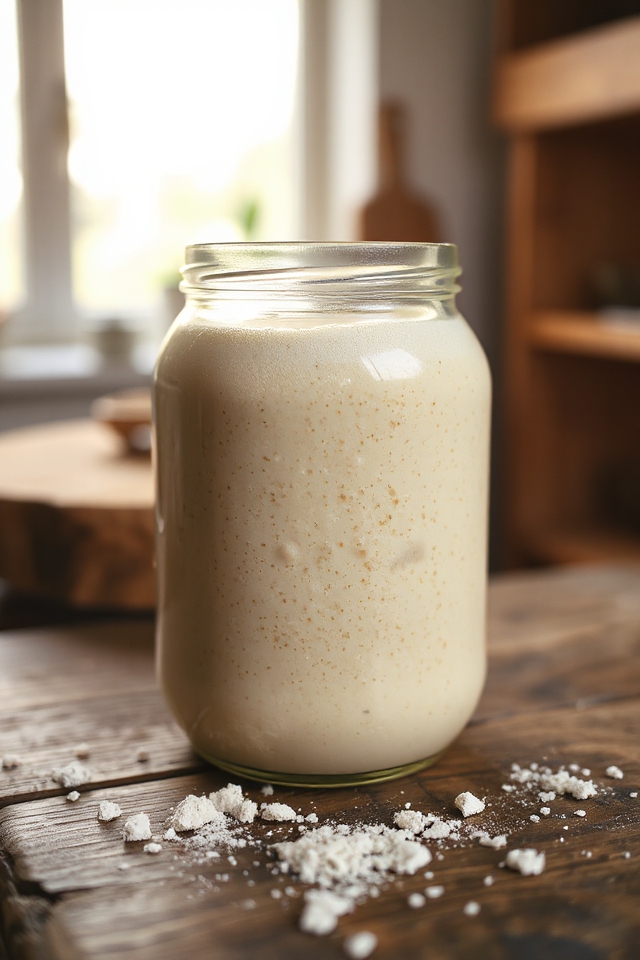Why You’ll Love This Sourdough Starter Recipe
If you’ve ever wanted to plunge into the world of baking, this sourdough starter recipe is a fantastic way to begin.
I love how simple and rewarding it’s to create my own starter. Watching it transform from a mixture into something alive is truly magical.
This recipe invites you into a community of bakers who cherish the art of sourdough. Plus, the flavor it adds to your bread is unbeatable—tangy and complex.
You’ll appreciate the satisfaction of nurturing your starter and the wonderful loaves it produces. Trust me, once you start, you won’t want to stop!
Ingredients of Sourdough Starter
When you’re ready to commence your sourdough journey, the first step is gathering your ingredients. This recipe is straightforward, but it’s essential to choose good-quality components for the best results.
I remember the first time I tried to make sourdough starter; I was so enthusiastic that I didn’t pay much attention to the ingredients. Spoiler alert: it didn’t turn out well.
But now, after a few more attempts (and a few more flops), I can confidently say that the right ingredients make all the difference. Let’s explore what you’ll need to get started.
Here’s the list of ingredients for your sourdough starter:
- 2 cups flour
- 1 (1/4 ounce) package active dry yeast or 1 (1/4 ounce) package cake yeast
- 1 1/2 cups tepid water
Now, a little note about the ingredients: the flour you choose can really affect the flavor and strength of your starter. Some folks swear by whole wheat flour for a more robust flavor, while others stick with all-purpose for a milder taste.
And don’t get me started on the yeast; using fresh yeast can make a world of difference. If you’re unsure, just go with what you have on hand, but keep in mind that experimenting is part of the fun.
How to Make Sourdough Starter

Alright, folks, let’s jump into the process of making your very own sourdough starter. It’s easier than you might think, and trust me, even if it feels a bit intimidating at first, you’ll soon find yourself in a delightful rhythm.
So, grab your ingredients—2 cups of flour, 1 (1/4 ounce) package of active dry yeast or cake yeast, and 1 1/2 cups of tepid water—and let’s get started.
First things first, in a large bowl or jar, mix that 1 (1/4 ounce) package of yeast with the 1 1/2 cups of tepid water. If you’re using active dry yeast, give it about 10 minutes to hang out and wake up a bit. It’s like a little yeast spa day!
While it’s frolicking in the water, you can measure out your 2 cups of flour. Once the yeast is bubbly and alive, sprinkle the flour right over that yeast mixture. Now, this is where the fun begins. Grab a whisk and stir it all together until you form a thick batter.
Don’t stress if it’s not perfectly smooth; think of it as rustic charm. Cover the bowl with plastic wrap and place it somewhere warm—ideally between 80-85°F. Let it sit there for about 24 hours. You might find yourself peeking in every so often, just to see if anything is happening. Spoiler alert: it will become frothy and bubbly, and you’ll feel a little spark of joy when you see those bubbles.
Now, I’ve to admit, the first time I made a sourdough starter, I was so excited that I forgot to check the temperature. Can you guess what happened? Nothing. It was a total flop.
So, take my advice—find a warm spot, maybe near a sunny window or on top of the fridge, and let that batter do its thing. After a day, you should see some lovely bubbles forming, and that’s your cue that you’re on the right track.
Just imagine the delicious bread you’ll be able to make with this little starter. It’s a process, but isn’t that part of the fun? Embrace the journey, and soon enough, you’ll be a sourdough pro.
Sourdough Starter Substitutions & Variations
While creating your sourdough starter is a rewarding journey, you might find yourself in need of some substitutions or variations along the way.
If you don’t have active dry yeast, try using instant yeast instead; it works just as well. For a gluten-free option, substitute all-purpose flour with a gluten-free blend, but be aware that the fermentation process might differ.
You can also experiment with different flours like whole wheat or rye for unique flavors. If you want to speed things up, add a bit of store-bought sourdough starter to kickstart the fermentation.
Happy baking!
Additional Tips & Notes
To guarantee your sourdough starter thrives, it’s important to maintain a consistent feeding schedule.
I recommend feeding it once a day if you keep it at room temperature, or every 5-7 days if you store it in the fridge. Always use filtered water to avoid chlorine, and feel free to experiment with different flour types for unique flavors.
If your starter develops a dark liquid on top, don’t worry; just stir it back in or pour it off.
Finally, trust your instincts—if it smells sour and bubbly, you’re on the right track.
Happy baking!
